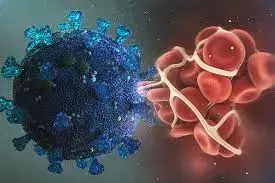- Home
- Medical news & Guidelines
- Anesthesiology
- Cardiology and CTVS
- Critical Care
- Dentistry
- Dermatology
- Diabetes and Endocrinology
- ENT
- Gastroenterology
- Medicine
- Nephrology
- Neurology
- Obstretics-Gynaecology
- Oncology
- Ophthalmology
- Orthopaedics
- Pediatrics-Neonatology
- Psychiatry
- Pulmonology
- Radiology
- Surgery
- Urology
- Laboratory Medicine
- Diet
- Nursing
- Paramedical
- Physiotherapy
- Health news
- Fact Check
- Bone Health Fact Check
- Brain Health Fact Check
- Cancer Related Fact Check
- Child Care Fact Check
- Dental and oral health fact check
- Diabetes and metabolic health fact check
- Diet and Nutrition Fact Check
- Eye and ENT Care Fact Check
- Fitness fact check
- Gut health fact check
- Heart health fact check
- Kidney health fact check
- Medical education fact check
- Men's health fact check
- Respiratory fact check
- Skin and hair care fact check
- Vaccine and Immunization fact check
- Women's health fact check
- AYUSH
- State News
- Andaman and Nicobar Islands
- Andhra Pradesh
- Arunachal Pradesh
- Assam
- Bihar
- Chandigarh
- Chattisgarh
- Dadra and Nagar Haveli
- Daman and Diu
- Delhi
- Goa
- Gujarat
- Haryana
- Himachal Pradesh
- Jammu & Kashmir
- Jharkhand
- Karnataka
- Kerala
- Ladakh
- Lakshadweep
- Madhya Pradesh
- Maharashtra
- Manipur
- Meghalaya
- Mizoram
- Nagaland
- Odisha
- Puducherry
- Punjab
- Rajasthan
- Sikkim
- Tamil Nadu
- Telangana
- Tripura
- Uttar Pradesh
- Uttrakhand
- West Bengal
- Medical Education
- Industry
D-dimer alone not specific in initiating anticoagulant prophylaxis in children: BMJ Study

There is scarce information on thrombotic complications in children to date, hence David et al performed a study that describes thrombotic complications in children with SARS-CoV-2 infection.
Among adults a significant prevalence of thrombotic complications in SARS-CoV2 infection has been reported and accordingly specific guidelines on anticoagulant management in COVID-19 infection in adults were published. However due to low experience of COVID-19 disease in children, these guidelines have not included specific recommendations for pediatric patients.
Researchers conducted a multicenter prospective national cohort study in children younger than 18 years of age infected by SARS-CoV-2 that included 537confirmed cases attending at 49 hospitals. Thrombotic complications associated with SARS-CoV- 2 infection were defined as any radiologically confirmed thrombosis, arterial or venous, occurring close to the diagnosis of SARS-CoV-2 infection (up to 3 weeks).
In the study 68.5% were hospitalized among which 10.8% cases needed pediatric intensive care. D-dimer values were available in 169 patients, with a median of 1071 μg/L . Anticoagulant drugs (heparin in all cases) were administered to 29 patients: as prophylaxis in 24 cases, and as treatment in 5 cases. Most of the patients on thrombo-prophylaxis had severe COVID-19.
Four cases, which correspond to 0.7% out of the global cohort and 1.1% out of the hospitalized patients, developed some thrombotic complication. Fifth case with thrombosis not related to covid infection was not included in this analysis. Three out of four were adolescents girls and none of them has MIS-C. D-dimer was significantly elevated in two patients(5953µg/L and 35420µg/L) and the other two patients had mild elevation. Only one patient received thrombo-prophylaxis (low-weight heparin) before thrombosis.
All four cases had thrombosis affecting the limbs, with cerebral venous sinus thrombosis and pulmonary embolism in one of them. All patients were treated with heparin and discharged without sequelae.Only two out of four cases had significant thromboic risk factors (central venous catheter, obesity, malignancy or asparaginase treatment), highlighting the difficulty of predicting thrombotic complications in children with COVID-19 to initiate anticoagulant prophylaxis. One out of four cases had persistant elevation of lupus anticoagulant at followup.
The low incidence of thromboembolic complications in children with COVID-19, may be attributed to a different balance in coagulation homeostasis, with a higher concentration of antithrombotic serum factors (eg, alpha-2-macroglobulin)in children compared with adults.
In this large cohort, 68 of 169 (40.2%) had a value >1500 μg/L. However, only 2 of 68 (2.9%) cases developed a thrombotic complication. Therefore, the use of
the D-dimer value is not specific enough to make decisions regarding anticoagulant prophylaxis in children.
Authors conclude-considering the low incidence of thrombosis in children, not only D-dimer , factors, such as the age (considering adolescents especially vulnerable), coexistence of risk factors (eg, malignancy, indwelling central venous catheter, obesity, immobility) or MIS-C diagnosis, should be considered when initiating anticoagulant prophylaxis in children with COVID-19.
Source:BMJ pediatrics
Dr Kamal Kant Kohli-MBBS, DTCD- a chest specialist with more than 30 years of practice and a flair for writing clinical articles, Dr Kamal Kant Kohli joined Medical Dialogues as a Chief Editor of Medical News. Besides writing articles, as an editor, he proofreads and verifies all the medical content published on Medical Dialogues including those coming from journals, studies,medical conferences,guidelines etc. Email: drkohli@medicaldialogues.in. Contact no. 011-43720751


